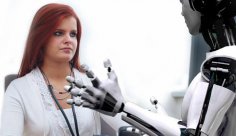Unitree G1 Bionic: Adaptive Upgrade – YouTube
See more
Researchers in China have created a new kind of humanoid robot that can walk and run on a variety of surfaces, reaching speeds of about 4.5 miles per hour (7.2 kilometers per hour).
Locomotion and walking have always been a challenge for bipedal robots, as bipedal locomotion is inherently unstable. We move by essentially allowing ourselves to fall forward before catching ourselves with the other leg, and then repeating the cycle. However, this type of locomotion has been difficult for developers to replicate in robotics programming, as it runs counter to the robot’s need to maintain balance.
Chinese robotics company Unitree has tackled this challenge with its G1 Bionic robot, which uses 3D lidar sensors and depth-sensing cameras to allow the device to perceive its environment in real time and continually adjust its posture. The robot’s joints use force-control technology to dynamically adjust its power output, helping it maintain balance.
Unitree recently released a video showing the G1 Bionic moving and running on hills, railroad ties, and rocky terrain. However, the video doesn't show the robot starting to run or changing speed, so it's unclear how well it performs on these tasks.
The developers created a control AI for the robot that mimics human movements on different landscapes, training it on a data set that covers the movements of the entire human body. The rhythmic running of the G1 Bionic resembles a runner with an accentuated stride.
Many modern industrial robots require either regular battery recharging or constant connection to a power source. Given the environment in which Unitree is demonstrating its adaptive robot and the lack of visible power cables, it is safe to assume that the G1 Bionic is also battery powered. However, it is unknown how long its battery can last.
A humanoid robot would likely have a natural advantage in environments designed for human movement, such as cities and buildings. If the robot could also carry things while running, it could become a valuable aid to emergency services in critical situations, for example.

Peter Ray EllisonSocial Links Navigation
Peter is a qualified engineer and an experienced freelance journalist specialising in science, technology and culture. He has written for a variety of publications including the BBC, Computer Weekly, IT Pro, The Guardian and The Independent. Peter has been working in technology journalism for over ten years. He holds a degree in Computer Engineering from Sheffield Hallam University. He has experience working in both the engineering and architecture sectors for companies including Rolls-Royce and Arup.
Before leaving a comment, you must verify your public display name.
Please log out and log back in. You will then be prompted to enter a display name.
Log out
Sourse: www.livescience.com




